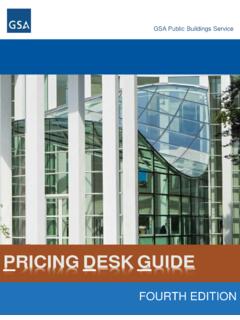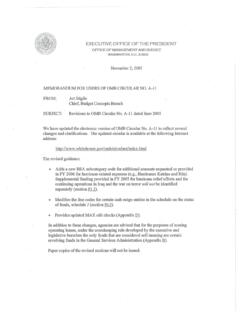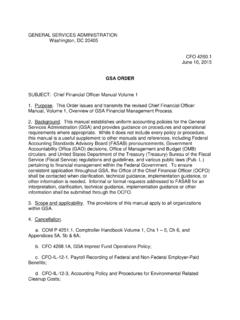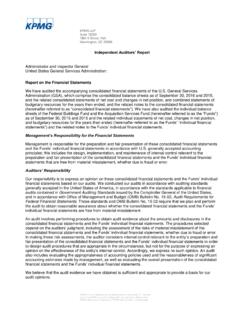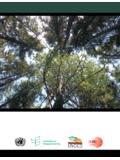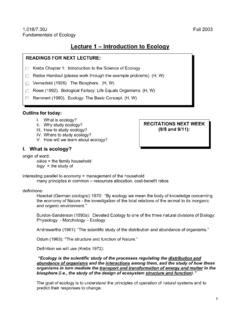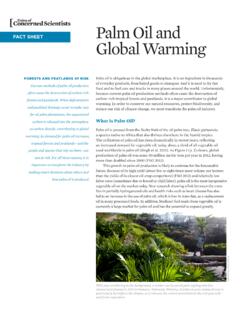Transcription of MAY 2011 - General Services Administration
1 The Benefits and Challenges of Green Roofs on Public and Commercial BuildingsA Report of the United States General Services AdministrationMAY 2011 Front cover: Image of the green roof on the United States Department of Transportation Headquarters GSA GREEN ROOF BENEFITS AND CHALLENGESTABLE OF CONTENTSCONTENTSEXECUTIVE Purpose of Study .. Methodology .. Background to Green Roofs .. Cost .. Scope of Report .. BENEFITS .. Stormwater Management .. Biodiversity and Habitat .. Urban Heat Island .. Energy .. Urban Agriculture .. Acoustics .. Air Quality .. Aesthetics and Quality of Life .. Job Generation and Economic Development .. Roof Longevity .. COST BENEFIT ANALYSIS ..673 .1 P u r p o s e .. Methodology .. Assumptions .. Results .. CHALLENGES TO GREEN ROOF Siting and Design .. Installation and Construction .. Maintenance and Operation ..83 GSA GREEN ROOF BENEFITS AND CHALLENGESTABLE OF CONTENTSGSA GREEN ROOF BENEFITS AND CHALLENGESTABLE OF RESEARCH AND DATA NEEDS.
2 Stormwater Management .. Biodiversity and Habitat .. Urban Heat Island .. Energy .. Acoustics .. Urban Agriculture .. Air Quality .. Job Generation and Economic Development .. Aesthetics and Quality of Life .. CONCLUSION ..95 DEFINITIONS, ABBREVIATIONS AND ACRONYMS ..99 APPENDIX A ..105 APPENDIX B ..109 BIBLIOGRAPHY ..117 REFERENCES ..129 CONTENTS CONT DGSA National Capital Region - United States Census Bureau Headquarters, Suitland, MarylandThe facility includes two extensive and intensive green roofs that total 85,000 square feet made accessible through walking SUMMARYGSA GREEN ROOF BENEFITS AND CHALLENGESiEXECUTIVE SUMMARYBACKGROUNDC ities create remarkable social environments out of what had been untouched natural landscapes. It is important to understand what is lost in that process as well. Besides being attractive, natural landscapes absorb and infiltrate stormwater, provide cooling from excess heat, offer habitats to a diversity of species, and improve air and water quality.
3 The urban hardscape a term for heavily urbanized areas with little bare soil cuts cities off from these natural processes and creates problems like water pollution and increased temperatures through the urban heat island. Green roofs sometimes referred to as vegetated roofs or eco-roofs consist of a waterproofing membrane, growing medium (soil) and vegetation (plants) overlying a traditional roof. Green roofs can help mitigate the problems that cities create by bringing the natural cooling, water-treatment and air filtration properties that vegetated landscapes provide to the urban environment. Architects and planners can use green roofs to help solve environmental problems by bringing nature back to the city in key ways. Green roofs properly designed, constructed and maintained, are beneficial socially, environmentally and fiscally. They are an important tool to increase sustainability and biodiversity and decrease energy consumption, urban heat island impacts and greenhouse gas OF STUDYC ongress authorized this study of green roofs.
4 This report reached its findings through an extensive review and analysis of about 200 research studies on the costs, benefits, challenges and opportunities of green roofs, along with an original cost-benefit analysis, discussion of best practices and assessment of further research needs. A in-depth analysis of the benefits, challenges and opportunities of alternative roofs such as conventional roofs or white roofs was beyond the scope of this report. GREEN ROOFS IN THE UNITED STATESG reen roofs have been around a long time. Prairie homesteaders built sod houses when settling the frontier. There have been green roofs on US Government buildings and parking structures for nearly a century green roofs installed on several federal buildings in the Washington DC region have not been replaced since their installation in the 1930s. Although they have been used infrequently for decades, green roofs are now being revived and studied for their environmental benefits.
5 The growth of green roofs in the US mirrors their use in other countries, like Germany, where they are more commonly seen. The General Services Administration (GSA) has designed and maintained green roofs for decades and finds them to be economical amenities that make fiscal and environmental sense. The GSA currently maintains at least 24 green roofs in 13 cities around the country. GSA routinely installs green roofs on new and existing ROOFSC onventional roofs are often known as black roofs, their traditional color. They are descended from the tar beach roofs once common in urban areas, and are still petroleum-based, whether made of polymer-EXECUTIVE SUMMARYGSA GREEN ROOF BENEFITS AND CHALLENGES iimodified bituminous sheets or synthetic rubber. Black roofs absorb significant energy from the sun and can reach temperatures as high as 150 F in summer. During storms, runoff from black roofs flows immediately into storm sewer systems, contributing to flooding and water pollution creating environmental and human health hazards, particularly where stormwater and sewage systems are combined.
6 Excessive stormwater runoff erodes soils and river banks and adds sediments and street pollutants to water is a third type of roof that is increasing in popularity the cool or white roof. These roofs are made of light-colored material and do not heat up as much as black roofs in the sun. They, however, share the runoff problems of black ROOF TYPESA typical green roof includes a waterproof barrier to protect the building, a drainage layer to store and direct runoff, a soil or growth medium layer, and a plant are two main types of green roofs: extensive roofs, which are relatively inexpensive to install and are used mainly for environmental benefit, and intensive roofs which allow a greater variety and size of plants such as shrubs and small trees but which are usually more expensive to install and maintain, partly due to the need for irrigation. Commercial and public buildings tend to use extensive roofs unless the roofs are intended primarily as occupied garden amenity space.
7 Extensive roofs have a thin soil layer and feature succulent plants like sedums that can survive in harsh conditions. Extensive roofs require little maintenance once they are established, and are generally cost-effective, particularly in buildings with long life spans. Intensive roofs have a thicker soil layer and should be considered a landscape with plants found in parks and gardens. These plants may require irrigation during dry periods. Because of their thicker soil, intensive roofs require greater structural support than extensive ones. However, intensive roofs also have greater potential for ecological benefit and amenity use than extensive roofs. GREEN ROOF COSTS AND BENEFITSThe environmental benefits of installing green roofs on commercial and public buildings include: Improved water quality due to reduced stormwater runoff and fewer overflows of combined sanitary and stormwater sewage systems Increased habitat promoting biodiversity Lower temperatures for building roofs and the air above them in most climates Reduced energy consumption in some climates Improved sound absorption in the top floors of buildings Improved air quality The economic costs of installing green roofs on commercial and public buildings include the cost of installing and maintaining the roof.
8 The economic benefits of installing green roofs include: Lower energy costs due to the cooling effect of plant respiration and the insulation, shading and thermal mass of the plant and soil layers A less frequent roof replacement schedule due to greater durability than conventional roofs Reduced stormwater management costs The creation of job opportunities in roof installation and maintenance and in the emerging field of urban agricultureGreen roofs provide a payback (based on a 50-year average annual savings) of approximately years nationally (internal rate of return of ) and years in Washington DC (internal rate of return of ), and conservative analysis puts the average life expectancy of a green roof at 40 years, versus 17 for a conventional the National Capital Region, if green roofs were to replace conventional roofs on all 54 million square feet of real estate (an estimated million square feet United States Department of Transportation Headquarters, Washington DCEXECUTIVE SUMMARYGSA GREEN ROOF BENEFITS AND CHALLENGES iiiof roof area), the cost-benefit analysis projects a 50-year NPV of $ million, or $ per square foot of building area.
9 The community, or public benefits in the National Capital Region could total almost $180 million, or $ per square foot of building area. These financial benefits will likely increase as installation and maintenance premiums fall, energy costs rise, and stormwater regulations TO GREEN ROOF CONSTRUCTIONThe main design, installation and management challenges of green roofs include: Ensuring the building can support a green roof Quality installation and leak prevention Maintenance requirements Potential plant loss due to environmental conditions or mismanagement, among other itemsDesigners can maximize the benefits of green roofs by properly selecting plants, growth medium, drainage layers and other features tailored to the local climate and the building s RESEARCH AND DATA NEEDSA dditional research in several issue areas is critical to better understanding the costs, benefits, challenges and opportunities of green roofs.
10 These issues include: A thorough comparison of green and white roofs Stormwater and storm dynamics, field monitoring and computer simulation Validating stormwater runoff and delayed peak runoffs for stormwater regulation The interaction between green roofs and solar panels Long-term stormwater and energy performance The process of establishing native plants and created habitat for endangered fauna on green roofs Green roofs influence on building energy use A thorough review of irrigated and non-irrigated roofs The economics of rooftop agriculture Air quality improvements associated with green roofs Employment analysesResearch has identified the following benefits for green roofs:STORMWATER MANAGEMENT In a typical urban area, rain that falls onto paved or built-on surfaces quickly flows into storm sewers and out into a nearby body of water. This excess stormwater runoff can cause numerous environmental problems, including damaging water quality by sweeping urban pollutants into water bodies, eroding river banks and flooding.

